INSIGHTS: Collecting Dust Jackets / Wrappers
- David Morris

- Jun 5, 2019
- 4 min read
Updated: Jun 6, 2019

There are a few things to consider when collecting any first edition to avoid disappointment. Many dust jackets from the Bodley Head, Early Collins and Transitional Collins periods (see https://www.collectingchristie.com/post/uk-first-edition-hardbacks for a description of these periods) are not authentic original jackets, which I define as the jacket that originally covered the book it is currently on, and few are unrestored. There is nothing wrong with acquiring a non-original jacket but full disclosure is rarely given and value will change. The most common considerations are as follows:

i. Marriage: Dust jackets may get placed onto a book from another source. Easy ways to tell when this has happened is to look for sunning/fading of the actual book in places that the jacket now covers. If an original chipped jacket is present, fading will match chipping. Marriage is not necessarily bad but some jackets are not the first issue version and I’ve seen many instances where dealers are not even aware of this. There are good resources online where one can buy facsimile dust jackets which allows you to compare the jackets. Also, jackets that have first edition artwork were often used on later editions, but trimmed down or repriced. For some of the very early Collins books the price was on the spine and a 3/6 sticker might be placed over the 7/6 price. For later publishings, the hardback book may have been slightly smaller, so jackets from these books were too small to fit the first edition, and when moved would appear trimmed on the top and bottom edges. Occasionally these trimmed jackets are obvious, but more often than not dealers are now hiring restorers to add back what was trimmed off. A married jacket that is still a correct first jacket is only marginally less valuable than a correct original jacket. Any other modification to a first edition jacket will have some detrimental value. Any later edition jacket is significantly less valuable, and in some cases will have no value beyond the hardback itself.
ii. Colonial Copies: Because Britain had many colonies and its Commonwealth encompassed dozens of nations, Collins distributed books worldwide. But pricing and currency was not consistent across these countries. In the Early and Transitional Collins periods many dust jackets were printed with no pricing (or if the price was on the spine a sticker was affixed over it). This was so the local country could determine pricing. These ‘Colonial’ jackets are still often correct first edition jackets. There are commonly viewed as only slightly less valuable than a UK priced jacket, but are certainly more valuable than a price-clipped jacket (see the next section).
iii. Price Clipped: While some Early Collins books had the price on the spine, most had the price on the bottom right corner of the inside from flap of the dust jacket. Some jackets would even have a diagonal dotted line essentially encouraging the purchaser to cut off the price if giving the book as a gift. US books often put the price on the top of the flap nearer meaningful text and didn’t visual encourage its clipping. For this reason, many Collins books ended up clipped, while US books rarely were. However, Collins also used the same jacket on cheaper printings for many of the Middle Collins era. So one could have two identical jackets - one priced 8 shillings and another with a 4 shilling price. Clearly the 8s was the first printing, but if you clipped the 4s price off who would know it wasn’t originally an 8s version. An unpriced Colonial Edition would still show the whole flap, with nothing printed on it. Thus, a price clipped dust jacket is less valuable than both a complete Colonial or unclipped correctly priced first.

iv. Restored: The skill of paper archivists has improved significantly over the years and the quality of a restoration can thus vary significantly. In terms of price impact there are generally two considerations: scope and quality. If the scope was small - i.e. didn’t impact lettering or crucial imagery and solely tidied up chipping at the extremities or tears, then the price impact is minimal and could be a positive. If the scope was large with large sections replaced, then the price discount could be significant. Quality is also crucial - does the restoration detract or improve and preserve. While all of these are subjective, a collector must decide whether they are will to acquire restored copies. Today, it is uncommon to find a Bodley Head or Early Collins that has not had some restoration, as this appears to be the preferred approach to preserving or adding value. The Transitional Collins period is the mostly likely to have unrestored copies with damage or loss to jackets. A skilled archivist could easily charge up to $1,000 for restoration work, so the pricing of these books is only just starting to warrant the investment in restoration. The best way to see what restoration has occurred is just to ask, and importantly request the seller to provide a photo of the rear of the dust jacket, illuminated from behind, or hold the jacket up to a light if you have access to it.




When I was a kid in college (during the closing of the ice age) there was an enormous used bookstore in Montclair, NJ, where they had a couple of shelves of vintage Christie volumes in original dust jackets. I regret to say that at the time my tastes ran more towards Edgar Rice Burroughs, so I never considered buying any of them. What I wouldn't do to be able to go back in time! I don't remember which ones they had but considering that I picked up an original British first of Day Of The Triffids (which I still own) in jacket for $15... it makes my head spin to imagine!